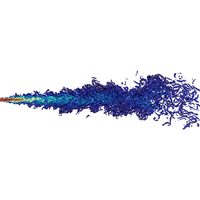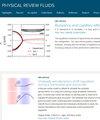Analysis of a turbulent round jet based on direct numerical simulation data at large box and high Reynolds number
IF 2.5
3区 物理与天体物理
Q2 PHYSICS, FLUIDS & PLASMAS
引用次数: 0
Abstract
We have conducted a direct numerical simulation of a turbulent round jet at a previously unattained Reynolds number of based on the jet diameter and jet-inlet bulk velocity in a particularly long box of . To achieve very fast convergence to self-similarity, we used a turbulent pipe flow at the same Reynolds number and length as the upstream inflow boundary condition. This indeed results in a very rapid emergence of self-similarity already at very small axial distances compared to all turbulent jet data published so far. Not only for the mean velocities and the Reynolds stresses as well as the budgets of the Reynolds stress tensor and the turbulent kinetic energy, a nearly perfect classical scaling based on the normalized radius in the range is shown, but also for the probability density function (PDF) of the axial velocity as well as the associated skewness and kurtosis. All budget terms have been calculated directly, resulting in a marginal error in the balance. An almost completely Gaussian behavior of the PDF for the axial velocity is observed on the jet axis, while a clear deviation with increasingly heavy tails is evident with increasing distance from the axis.

基于大方框和高雷诺数下直接数值模拟数据的湍流圆形射流分析
我们在一个 75D 的特长箱中,根据射流直径 D 和射流入口体积速度 Ub,在 Re=3500 的雷诺数条件下对湍流圆形射流进行了直接数值模拟。为了实现自相似性的快速收敛,我们使用了相同雷诺数和长度为 5D 的湍流管道流作为上游流入边界条件。与迄今为止公布的所有湍流射流数据相比,这确实导致在非常小的轴向距离 z 时就已经非常快速地出现了自相似性。在 z/D=25-65 范围内,不仅平均速度和雷诺应力以及雷诺应力张量和湍流动能的预算显示了基于归一化半径 η=r/z 的近乎完美的经典缩放,而且轴向速度 Uz 的概率密度函数(PDF)以及相关的偏度和峰度也显示了近乎完美的经典缩放。所有预算项都是直接计算得出的,因此平衡中存在边际误差。在射流轴上可以观察到轴向速度的概率密度函数几乎完全呈高斯分布,而随着与轴线距离的增加,明显出现了尾部越来越大的偏差。
本文章由计算机程序翻译,如有差异,请以英文原文为准。
求助全文
约1分钟内获得全文
求助全文
来源期刊

Physical Review Fluids
Chemical Engineering-Fluid Flow and Transfer Processes
CiteScore
5.10
自引率
11.10%
发文量
488
期刊介绍:
Physical Review Fluids is APS’s newest online-only journal dedicated to publishing innovative research that will significantly advance the fundamental understanding of fluid dynamics. Physical Review Fluids expands the scope of the APS journals to include additional areas of fluid dynamics research, complements the existing Physical Review collection, and maintains the same quality and reputation that authors and subscribers expect from APS. The journal is published with the endorsement of the APS Division of Fluid Dynamics.
 求助内容:
求助内容: 应助结果提醒方式:
应助结果提醒方式:


